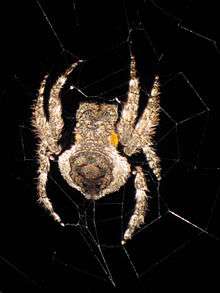Caerostris sexcuspidata
| Common bark spider | |
|---|---|
 | |
 | |
| Scientific classification | |
| Kingdom: | Animalia |
| Phylum: | Arthropoda |
| Subphylum: | Chelicerata |
| Class: | Arachnida |
| Order: | Araneae |
| Infraorder: | Araneomorphae |
| Family: | Araneidae |
| Genus: | Caerostris |
| Species: | C. sexcuspidata |
| Binomial name | |
| Caerostris sexcuspidata (Fabricius, 1793) | |
| Synonyms | |
| |
Caerostris sexcuspidata, also known as the common bark spider, occurs in Southern Africa, and on islands off the east coast of Africa, such as Madagascar, the Comores and Aldabra Island. It is a nocturnal orb-web spider, the female constructing a large orb web some 1.5 metres across, stretching between trees or shrubs. Its dorsal surface is cryptically coloured with horny projections which aid in camouflage; legs are drably coloured seen from above and clearly zebra-striped when viewed from beneath. During daylight hours she dismantles her web and retires to a nearby branch, tucking her legs, which are covered with fine hair, against her body, blending with the surroundings to resemble part of a branch, complete with growth bulges.[1] The common bark spider is the most widespread of the Bark spiders found in Southern Africa and shows considerable variation in abdomen shape. The abdomen protrudes over the carapace, while its eight small eyes are located on a tubercle at the front of the carapace.[2] Though mainly nocturnal, it may be found on its web in shady, forested areas during the day.
External links
References
| Wikimedia Commons has media related to Caerostris sexcuspidata. |